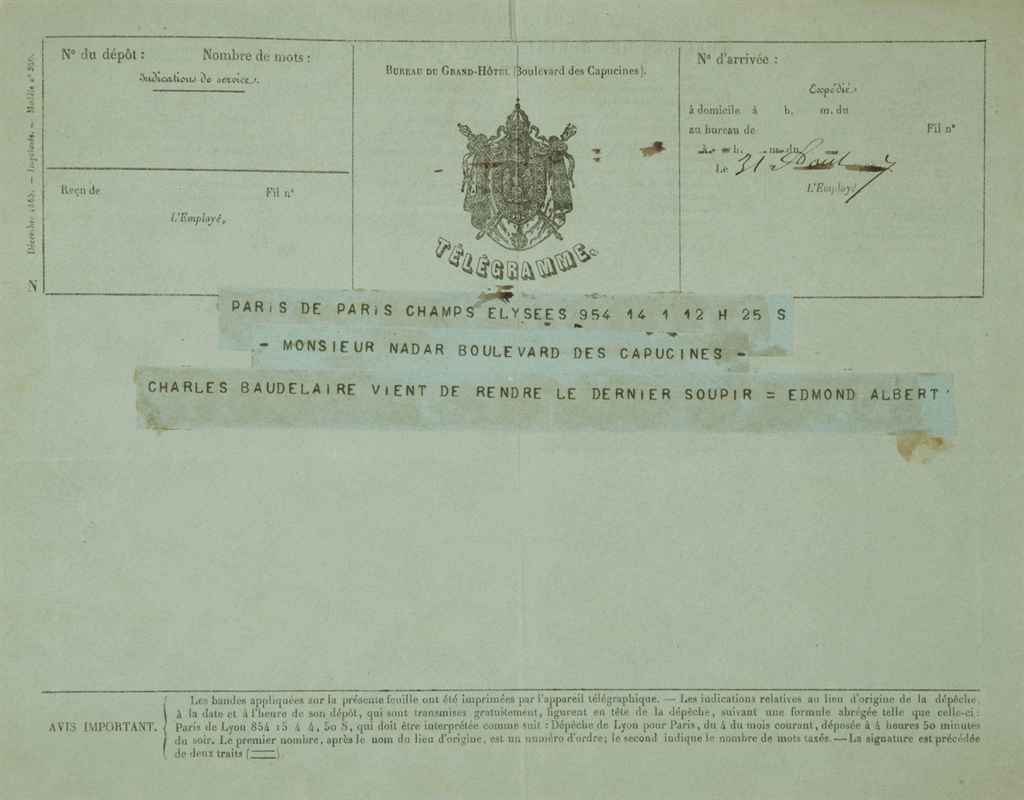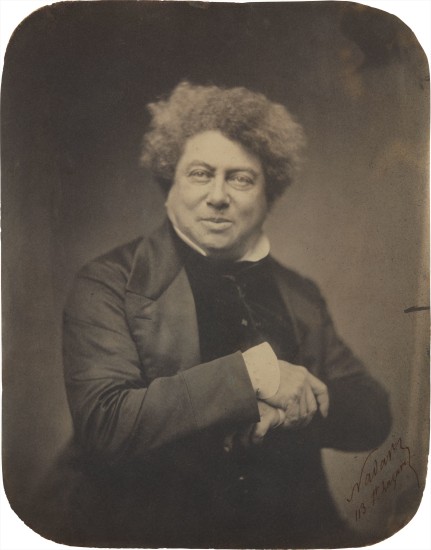THE ARC OF PHOTOGRAPHY: A PRIVATE EAST COAST COLLECTION Nadar (Gaspard-Félix Tournachon) and Adrien Tournachon Pierrot with Fruit 1854-1855 Salt print. 11 1/4 x 8 1/8 in. (28.6 x 20.6 cm). Signed and inscribed with a small drawing by Charles Deburau, the French mime, to his collaborator Négrier, in ink and 'Nadar Jne' stamp on the recto.
Provenance Private Collection, Paris; Olivier Renaud-Clément, New York Literature The Metropolitan Museum of Art, NADAR, pl. 12 Catalogue Essay The brothers Gaspard-Félix and Adrien Tournachon were born to an intellectual household in Paris, where their father, Victor Tournachon, ran a printing and publishing press and inculcated pursuit of academic excellence in the two boys. Following their father’s death in 1837, Gaspard-Félix left school, only to reinvent himself as Nadar. More than just a mark of initiation, the pseudonym provided a permit to restart where his life had stopped following his father’s death. Namely, as a young, playful child with the hope of fulfilling his potential. For the next decade Nadar struggled to make a living by writing articles, stories and caricatures for a number of marginal newspapers, while fraternizing with other likeminded intellectuals who delved into a Bohemian lifestyle of unfettered reality. It was during that period that Nadar co-founded the literary journal Livre d’or, further establishing his reputation as a magnet for the literary giants of the day, while continuously publishing stories in Le Commerce, Le Corsaire-Satan, submitting caricatures for Le Journal du dimanche and Le Charivari, and providing theatrical reviews for La Revue et gazette des theaters. Vaudeville was the predominant form of entertainment of the day, attracting a wide demographic cross-section, from commoners to the literati. At its helm were a number of revered performers, one of whom, Jean-Baptiste-Gaspard Deburau, successfully reinvented the commedia dellarte character of the clown-servant, Pierrot, formerly known as Harlequin: a powdered mime of acrobatic grace who represented the common man in his aspirations and personal trials and tribulations. Nadar’s love for performance lay in its ability to communicate. That is, for art to qualify as such, it could not be hinged on the Romantic principles of “art for art’s sake”, which Nadar found solipsistic. Rather, true art was about the dialogue (metaphorical and literal) between the performer and the audience, the lessons learned and the morals portrayed. It is for that very same reason that Nadar’s own writing and caricatures were driven by the wish to express, comment and react, invariably employing wit, sarcasm, intellect and a love for exaggeration in order to share, challenge and provoke. As a new, stringent and more censorship-prone regime rose to power in 1851, caricaturists and liberal literati alike stumbled upon inopportune times. The same year, the advent of Adolphe Bertsch’s collodion-on-glass negative process led to a surge in the number of photographic studios around Paris. Recognizing the commercial and artistic potential of photography, Nadar invited his younger brother Adrien, who had been unsuccessful in his search around Europe for employment as a painter, back to Paris to take an apprenticeship with the photographer Gustave Le Gray paid for by Nadar. Shortly thereafter, Adrien set up an atelier, and in 1854, at the brink of financial collapse, Nadar quickly interceded to salvage the studio, drawing from his personal funds, business acumen, and strong connections with financiers, artists and performers alike, including the then-leading Pierrot performer at the Théâtre des Funambules, Charles Deburau (son of Jean-Baptiste-Gaspard), whose signature and inscription to his collaborator Négrier can be seen in the lower right quadrant. A number of images of Pierrot were created in the studio in a series known as “têtes d’expression,” depicting the famed performer in a variety of exaggerated poses and expressions, in the current lot, marveling at an arrangement of fruit. It could be argued that the character of Pierrot became the perfect surrogate for Nadar’s love of caricatures for the heavy-handed outlining of emotions and predicaments that they both shared. Moreover, the character of Pierrot, like the photographer, was communicating visuals withou
THE ARC OF PHOTOGRAPHY: A PRIVATE EAST COAST COLLECTION Nadar (Gaspard-Félix Tournachon) and Adrien Tournachon Pierrot with Fruit 1854-1855 Salt print. 11 1/4 x 8 1/8 in. (28.6 x 20.6 cm). Signed and inscribed with a small drawing by Charles Deburau, the French mime, to his collaborator Négrier, in ink and 'Nadar Jne' stamp on the recto.
Provenance Private Collection, Paris; Olivier Renaud-Clément, New York Literature The Metropolitan Museum of Art, NADAR, pl. 12 Catalogue Essay The brothers Gaspard-Félix and Adrien Tournachon were born to an intellectual household in Paris, where their father, Victor Tournachon, ran a printing and publishing press and inculcated pursuit of academic excellence in the two boys. Following their father’s death in 1837, Gaspard-Félix left school, only to reinvent himself as Nadar. More than just a mark of initiation, the pseudonym provided a permit to restart where his life had stopped following his father’s death. Namely, as a young, playful child with the hope of fulfilling his potential. For the next decade Nadar struggled to make a living by writing articles, stories and caricatures for a number of marginal newspapers, while fraternizing with other likeminded intellectuals who delved into a Bohemian lifestyle of unfettered reality. It was during that period that Nadar co-founded the literary journal Livre d’or, further establishing his reputation as a magnet for the literary giants of the day, while continuously publishing stories in Le Commerce, Le Corsaire-Satan, submitting caricatures for Le Journal du dimanche and Le Charivari, and providing theatrical reviews for La Revue et gazette des theaters. Vaudeville was the predominant form of entertainment of the day, attracting a wide demographic cross-section, from commoners to the literati. At its helm were a number of revered performers, one of whom, Jean-Baptiste-Gaspard Deburau, successfully reinvented the commedia dellarte character of the clown-servant, Pierrot, formerly known as Harlequin: a powdered mime of acrobatic grace who represented the common man in his aspirations and personal trials and tribulations. Nadar’s love for performance lay in its ability to communicate. That is, for art to qualify as such, it could not be hinged on the Romantic principles of “art for art’s sake”, which Nadar found solipsistic. Rather, true art was about the dialogue (metaphorical and literal) between the performer and the audience, the lessons learned and the morals portrayed. It is for that very same reason that Nadar’s own writing and caricatures were driven by the wish to express, comment and react, invariably employing wit, sarcasm, intellect and a love for exaggeration in order to share, challenge and provoke. As a new, stringent and more censorship-prone regime rose to power in 1851, caricaturists and liberal literati alike stumbled upon inopportune times. The same year, the advent of Adolphe Bertsch’s collodion-on-glass negative process led to a surge in the number of photographic studios around Paris. Recognizing the commercial and artistic potential of photography, Nadar invited his younger brother Adrien, who had been unsuccessful in his search around Europe for employment as a painter, back to Paris to take an apprenticeship with the photographer Gustave Le Gray paid for by Nadar. Shortly thereafter, Adrien set up an atelier, and in 1854, at the brink of financial collapse, Nadar quickly interceded to salvage the studio, drawing from his personal funds, business acumen, and strong connections with financiers, artists and performers alike, including the then-leading Pierrot performer at the Théâtre des Funambules, Charles Deburau (son of Jean-Baptiste-Gaspard), whose signature and inscription to his collaborator Négrier can be seen in the lower right quadrant. A number of images of Pierrot were created in the studio in a series known as “têtes d’expression,” depicting the famed performer in a variety of exaggerated poses and expressions, in the current lot, marveling at an arrangement of fruit. It could be argued that the character of Pierrot became the perfect surrogate for Nadar’s love of caricatures for the heavy-handed outlining of emotions and predicaments that they both shared. Moreover, the character of Pierrot, like the photographer, was communicating visuals withou







.jpg)
.jpg)
.jpg)

Try LotSearch and its premium features for 7 days - without any costs!
Be notified automatically about new items in upcoming auctions.
Create an alert